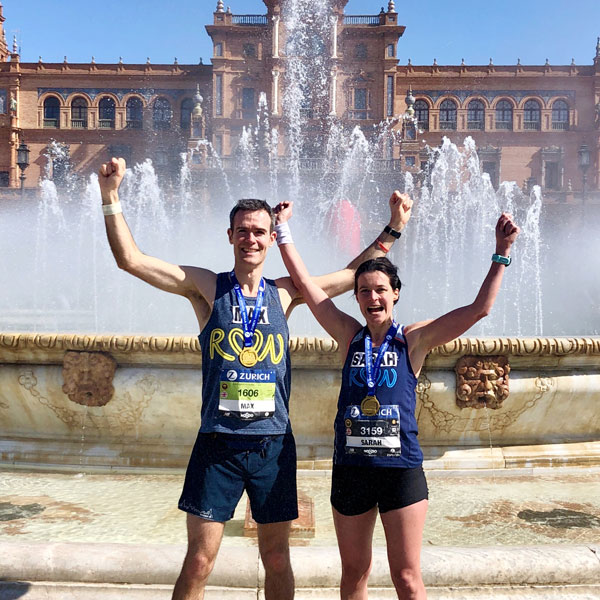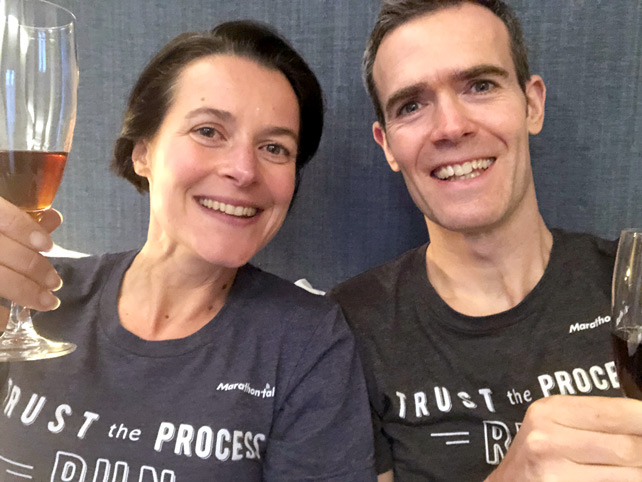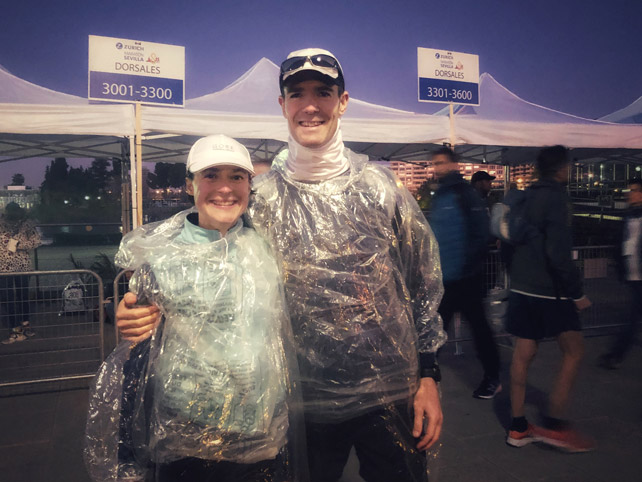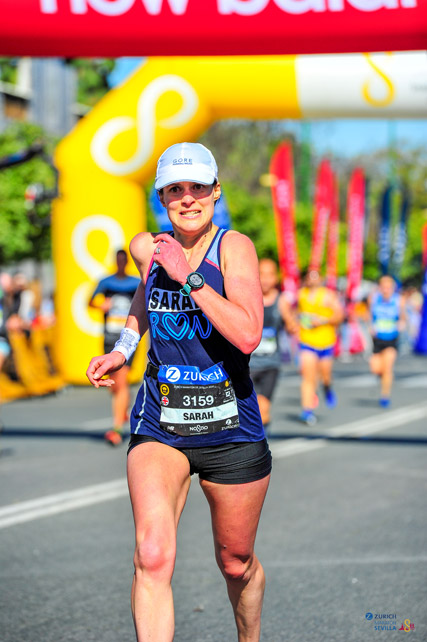
We are generally low key sharing our achievements, but Seville 2020 saw us both smash our PBs after 20 years of running and broadly plateauing in the last several years. As a result, many people have asked us, along the lines of, “How the @$%& did you do that?!” So, shackles off, here are our reflections on how we managed such a significant step change, although, spoiler alert, there is no magic; focus and hard work are at the heart of it.
Max:
Previous PB 2.58.51 San Sebastian, 2012 (aged 35)
Seville 2020: 2.47.32 (aged 42)
Sarah:
Previous PB 3.00.04 San Sebastian, 2016 (aged 39) and yes, you have read that right, 4 seconds over 3 hours, as well as 3 others 3.02 and under!
Seville 2020: 2.55.27 (aged 43)
Baseline: motivation and mindset
You can’t be ‘on’ all of the time, and in previous years we’ve probably been guilty of doing too many marathons (because we enjoy them) and not giving ourselves enough rest afterwards. In the last 2-3 years, we’ve also had a few races that haven’t gone our way due to bad conditions (the notorious Boston 2018) or getting ill shortly before the race (Boston 2019), things that are an inevitable part of a marathon runner’s experience.
With this conflux of circumstances, we decided we were really up for training hard for our target race of Tokyo 2020 (scheduled for 1st March 2020), making sensible choices not to run any extra autumn marathons, and even having a bit of a rest period around 5 months out from race day.
Once into the training, we approached each session with the respect it deserved. That meant if it was an easy run, we ran it easy, because we knew that that meant there was a brutal session coming soon, and we wanted to be able to give the tough session our absolute best efforts. We embraced this, and it may sound nerdy but we really did ‘Trust the Process’, quite literally wearing the T-Shirt to reinforce the mindset.

Brass tacks: our coach and training schedule
We wrote our own plans for years, using a mix of books and online resources. These were definitely good plans, but we definitely feel that turning to a pro in the last 2 years, with Lawrence from Run Your Best coaching, was an important part of our step up.
We’d call out a few features of the training strategy that we feel gave us an edge:
- As fairly experienced runners with a lot of miles in our legs over decades, we established a good base 3-4 months out with reasonable mileage (~50 miles per week) and some shorter punchier speed sessions, but had only a 9-week marathon-specific schedule that really stretched us, and then tapered us rapidly to race day. This links back to mindset because we had a real sense of making the most of every session.
- Peakier peaks and trough-ier troughs: a real hallmark of the schedule was more easy miles 3-4 times per week, and only 1-2 tough sessions per week that really stretched us. This seemed to give us that essential endurance baseline but developed our actual capability for speed endurance. Having a coach setting sessions that you wouldn’t dare set yourself was integral to our eventual results: daunting beforehand, but exhilarating afterwards.
- Higher mileage… but not by much: our mileage did go up compared with previous training, averaging ~65-75 miles per week, but remember that a lot of these miles were running easy. 10-13 mile easy runs were common, and actually confidence building, because the marathon distance doesn’t seem so unattainably far away.
More broadly, we feel it’s important to tune into our bodies and develop an intuitive understanding of how we’re feeling, how we are responding to the training, and when we’re over-fatigued rather than just have tired legs (because they always will be during marathon training!) This can help to fine tune the training schedule, but probably more importantly to interpret the results and build confidence in progress.
All-in: logistics, choices and trade-offs
We don’t talk about ‘sacrifices’ and ‘suffering’ in our training. These were our choices, and we were committed and loving it, but we had to be realistic that you can’t train this hard without making some choices and trade-offs.
We were ruthlessly organised, planning our days and weeks with the running schedule front of mind. Of course we had work and personal commitments that sometimes meant the running looked problematic at first sight. But generally where there is a will, there is a way: this meant 5am starts were frequent, creative and sometimes crazy logistics getting ourselves, work equipment and clothes into the right location, as well as missing out or having to take a ‘HIIT’ (i.e. high intensity, short duration!) approach to social commitments. We had to complete a 21 and 22 miler pre-9am before starting work in an especially intensive phase. And in particular, our evenings after work were very functional, just eating, sorting washing, putting out our kit for the next morning, and getting to bed.

While of course we can’t guarantee our health, we were as sensible as possible in taking steps to try to avoid illness, and we could control eating a good quality diet, recognising that recovery nutrition is particularly valuable, minimising alcohol, staying hydrated, and really prioritising sleep. We see sleep as the ultimate free super-power, and essential to endurance performance.
Clear the decks: pre-race preparation
You might have thought that we’d somehow confused Seville and Tokyo as you’ve been reading this! 6 days before our flight to Tokyo, the marathon was cancelled due to corona virus. While this seems blindingly obvious now, it came as a big shock at the time because it was the first big sporting event in the world to be cancelled, the decision was made very close to the event, and it was unthinkable that the marathon and Olympics later in the year could be cancelled or postponed. We’ll be honest, the news sent us reeling and momentarily in denial, but within 24 hours, we’d cancelled our entire trip-of-a-lifetime to Japan and registered for Seville Marathon instead, which was a week earlier than Tokyo, i.e. 6 days away.
We’d also given ourselves some impossibly complicated logistics, moving flats, and Sarah working at the annual Marathon Talk Run Camp before going directly to the airport. We had to overhaul our plans, and give full focus to ensuring we got to Seville. With hindsight, we probably had taken on too much too close to the race, but our training wasn’t immune to real life.
While these few chaotic days are definitely one aspect that we’d strongly recommend against, once we got to Seville and had got our race packs, we did shut everything else out. We made sure we had a good pre-race dinner planned, we recce’d the start area and bag drop the day before, and we wrote down a detailed timetable for race day morning for getting up, eating and getting to the start line.
We also went through the exercises in The Sporting Brain Box, a collaboration between Sarah & Sports Psychologist Dr Josie Perry. We found the individual exercises really useful for highlighting key strengths to draw on in the race, recognising why we should be confident, and having clarity on our goals, but almost more importantly it meant enjoyable focus and immersion into running and race day, to the exclusion of life’s usual admin.
Liberation: run for your life!
We’ve always been strong believers in the significance of a relaxed but focused mental state for marathon running. Have you noticed having a bad run when you’ve had an argument or something at work is really winding you up? Just observe Kipchoge as a zen-like masterclass, and it’s no coincidence he’s the best marathon runner on the planet.
Strangely, the stress and disruption of the week before Seville had a silver, or perhaps golden, lining for us, and couldn’t have been a stronger validation of this theme. Because we’d had the rug pulled from under our feet when Tokyo was cancelled, just being on the start line at Seville was a triumph. We had a huge sense of gratitude that somehow the stars had realigned to enable us to be there, in great health (albeit with one week less taper than planned), and in near perfect running conditions. We’d been given a second chance and had a sense of exhilaration and the sheer joy of being able to run. So we actually felt much more relaxed than usual on the day, felt no self-imposed pressure, and got ourselves into the race start pens in great spirit and a nothing-to-lose frame of mind.

Sarah even stayed calm when seconds over the start line, she was hit by a runner coming the other way! She is the runner circled in the white cap in this video cover, and you can see her getting run into in the video! At the time she thought the runner was late for the start, but it turns out he had lost his shoe in the starting melee and was going back for it! Understandable in the circumstances and thankfully no harm done.
Sarah grew more and more confident as the miles flew by, and ran her 5 minute PB with exemplary even splits, even though she was running mainly on feel.

Max felt great from the first pace, and after patiently pacing the first half, decided he still felt strong and that it was a first-in-a-lifetime opportunity just to run harder and harder as the miles ticked by as long as he still felt great. All sense of pacing to a target time went out the window (usually this is what happens when you’re slowing down and just holding on to make it to the finish!) and Max ended up running a time he never imagined possible, an 11 minute PB, with a 4 minute negative split, and even ran a Half Marathon PB of 1.21.48 in the second half!

While it would be impossible to recreate this exact set of circumstances, we will never forget the Seville 2020 experience, and will endeavour to recreate that sense of liberation on the start line: all the training is done, nothing else matters at this moment, and enjoy the chance to revel in the joy of running, uninterrupted for the next few hours.
Background basics
We should probably mention a few other things that we regard as our staples, and all contribute to being able to put the marathon-specific training together:
Shared endeavour:
We recognise we are incredibly lucky that we can run together as husband and wife, and we always reflect on how important it is for us that we can motivate each other through the early starts, the niggles and injuries, and the ups and downs of day-to-day sessions, as well as work together on the practicalities of the logistics we described before. Whatever your preferred option, whether through a coach, family and friends, running clubs, or virtual communities, we think it’s hugely valuable, and actually we believe it’s the shared endeavour of the overall project that is more important than necessarily running side-by-side with someone.




Track sessions:
We do the vast majority of our sessions independently, but we’re members of Abingdon AC and Serpentine RC, and there is nothing like a good blast around the track once a week or fortnight. Even though our actual track performance is pretty poor because we’re usually endurance training, it gets the leg speed up and stretches us through the friendly competitive dynamic. A good Yasso 800s session is a particularly brutal but beautiful gem (and can potentially help predict your marathon time).
Training races:
We usually like to fit one or two training races into our build-up, a 10K or 1/2M. They are a good experience to test ourselves, feel sharp and get the adrenaline flowing, they are nice milestones to aim at within the schedule, and a 1/2M in particular is a good check-in on where we are on pace to help us set stretching but realistic targets for our target marathon. As it happens, for Seville/ Tokyo 2020, we didn’t actually manage to fit any in because there aren’t many races so early in the year, but it obviously wasn’t a problem this time. Maybe that’s also why we surprised ourselves with our times!
Runtech:
We are firm believers that the ‘engine’ is the most important thing to focus on, i.e. you! We have low tech Garmin watches, wear a pace pocket to remind ourselves of our target times when our brains can’t cope with the maths mid-race, and otherwise have no fancy gadgetry.
However, we are often asked, ‘do you wear “those shoes”?’ The answer is yes, we wore the Nike Vaporfly Ekidens, and we also use the Maurten gels as in-race fuel. Running is our passion, and it seems crazy not to embrace technological developments that have a global evidence base for improving performance. It would certainly be a good thing if a specification was set out to calm any controversy, but let’s be realistic that shoe technology has made numerous breakthroughs and step changes since Abebe Bikila won the Olympic Marathon in Rome 1960 running barefoot. The latest Nike’s are just one more step in a long trajectory, and they don’t do the running for you (or indeed work well for everyone), the most important thing is still the ‘engine’.
Sports massage:
When in periods of intensive training, a good sports massage on the legs and back are a great investment. We are indebted over the years to Roberto.
Strength and mobility:
It’s always a dilemma how to fit everything in, but we have prioritised into our schedule 1-2 sessions per week over the last 15 years of either yoga, core strength and/ or other conditioning training, generally bodyweight, reformer pilates or kettlebells. It’s a great balance to the running, highly complementary and increasingly important as we all get older.
Finish Line
That’s it! When we’ve had a great race, we certainly wish we could ‘bottle the formula’ and serve it up perfectly next time. But one of the tantalising attractions of marathon running is that you just can’t do that, and you can’t control the weather and all those other external factors either.
We will treasure our Seville 2020 experience forever, regardless of whether we go on to set new PBs or not. We decided we’d record our reflections on how such a great performance came together for us, and we’ll see if we can build all these elements and new learnings into our next major race effort, and we hope there might be a few helpful strands in there for you too.
Keep running and keep smiling!

Really interesting and useful – thanks!
Thank you so much Tom, very pleased to hear it. Here’s to keeping improving as we get older! Sarah